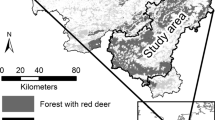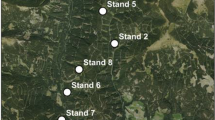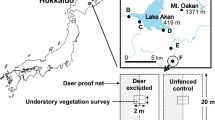Abstract
The management of deer impacts on forested lands requires quantification of the negative factors (e.g., bark stripping) on tree survival in relation to other ecological variables (e.g., competition from neighboring trees). This study measured the effects of bark stripping by sika deer, Cervus nippon, and competition among trees on the survival of Abies veitchii in a subalpine coniferous forest in central Japan over 12 years. Most of the trees subjected to bark stripping by deer were small (< 10 cm in diameter at breast height); however, some trees were stripped repeatedly. Although light bark stripping did not strongly influence tree survival after 12 years, heavily stripped stems (i.e., > 65% of the stem circumference stripped) were severely affected. The effect on longevity for each tree after bark stripping was explained by maximum bark stripping intensity during the study period, rather than initial bark stripping intensity. When > 85% of the stem circumference had been stripped, survival rates decreased. Bark stripping influenced survival rates much more than competition from neighboring trees. Because bark stripping occurred repeatedly, frequent measurements are important to grasp the full effects caused by this action. Heavy bark stripping of a stem enhances tree mortality. Thus, management of bark stripping is an essential element of stand maintenance and species composition in subalpine coniferous forests in Japan.






Similar content being viewed by others
References
Akashi N, Nakashizuka T (1999) Effects of bark-stripping by Sika deer (Cervus nippon) on population dynamics of a mixed forest in Japan. Forest Ecol Manag 113:75–82
Akashi N, Terazawa K (2005) Bark stripping damage to conifer plantations in relation to the abundance of sika deer in Hokkaido, Japan. Forest Ecol Manag 208:77–83
Akashi N, Unno A, Terazawa K (2015) Significance of woody browse preferences in evaluating the impact of sika deer browsing on tree seedlings. J Forest Res 20:396–402
Arhipova N, Jansons A, Zuluma A, Gairnieks T, Vasaitis R (2015) Bark stripping of Pinus contorta caused by moose and deer: wounding patterns, discoloration of wood, and associated fungi. Can J Forest Res 45:1434–1438
Borkowski J, Ukalski K (2012) Bark stripping by red deer in a post-disturbance area: the importance of security cover. Forest Ecol Manag 263:17–23
Bradshaw L, Waller DM (2016) Impacts of white-tailed deer on regional patterns of forest tree recruitment. Forest Ecol Manag 375:1–11
Coates KD, Lilles EB, Astrup R (2013) Competitive interactions across a soil fertility gradient in a multi species forest. J Ecol 101:806–818
Fraver S, D’Amato AW, Bradford JB, Jonsson BG, Jönsson M, Esseen PA (2014) Tree growth and competition in an old-growth Picea abies forest of boreal Sweden: influence of tree spatial patterning. J Veg Sci 25:374–385
Gill RMA (1992) A review of damage by mammals in north temperate forests: 1. Deer. Forestry 65:145–169
Hidding B, Tremblay JP, Côté SD (2012) Survival and growth of balsam fir seedlings and saplings under multiple controlled ungulate densities. Forest Ecol Manag 276:96–103
Holzwarth F, Kahl A, Bauhus J, Wirth C (2013) Many ways to die-partitioning tree mortality dynamics in a near-natural mixed deciduous forest. J Ecol 101:220–230
Iijima H, Nagaike T (2015a) Susceptible conditions for bark striping by deer in subalpine coniferous forests in central Japan. Forest Ecosyst 2:33
Iijima H, Nagaike T (2015b) Appropriate vegetation indices for measuring the impacts of deer on forest ecosystems. Ecol Ind 48:457–463
Iijima H, Nagaike T, Honda T (2013) Estimation of deer population dynamics using a Bayesian state-space model with multiple abundance indices. J Wildl Manag 77:1038–1047
Jiang Z, Ueda H, Kitahara M (2005) Bark stripping by sika deer on veitch fir related to stand age, bark nutrition, and season in northern Mount Fuji district, central Japan. J Forest Res 10:359–365
Kaji K, Saitoh T, Uno H, Matsuda H, Yamamura K (2010) Adaptive management of sika deer populations in Hokkaido, Japan: theory and practice. Popul Ecol 52:373–387
Kanzaki M (1984) Regeneration in subalpine coniferous forests. I. Mosaic structure and regeneration process in a Tsuga diversifolia forests. Bot Mag Tokyo 97:299–311
Kupferschmid AD, Bugmann H (2008) Ungulate browsing in winter reduces the growth of Fraxinus and Acer saplings in subsequent unbrowsed years. Plant Ecol 198:121–134
Kupferschmid AD, Wasem U, Bugmann H (2014) Light availability and ungulate browsing determine growth, height and mortality of Abies alba saplings. Forest Ecol Manag 318:359–369
Kupferschmid AD, Wasem U, Bugmann H (2015) Browsing regime and growth response of Abies alba saplings planted along light gradients. Eur J Forest Res 134:75–87
Masaki T, Mori S, Kajimoto T, Hitsuma G, Sawata S, Mori M, Osumi K, Sakurai S, Seki T (2006) Long-term growth analyses of Japanese cedar trees in a plantation: neighborhood competition and persistence of initial growth deviations. J Forest Res 11:217–225
Miyadokoro T, Nishimura N, Yamamoto S (2003) Population structure and spatial patterns of major trees in a subalpine old-growth coniferous forest, central Japan. Forest Ecol Manag 182:259–272
Nagaike T (2003) Edge effects on stand structure and regeneration in a subalpine coniferous forest on Mt. Fuji, Japan, 30 years after road construction. Arc Antarc Alpine Res 35:454–459
Nagaike T (2012) Effects of browsing by sika deer (Cervus nippon) on subalpine vegetation at Mt. Kita, central Japan. Ecol Res 27:467–473
Nagaike T, Hayashi A (2003) Bark-stripping by sika deer (Cervus nippon) in Larix kaempferi plantations in central Japan. Forest Ecol Manag 175:563–572
Nagaike T, Takanose Y (2014) Growth and competitive effects of planted and naturally regenerated trees in a plantation—a case study of an old Larix kaempferi plantation in central Japan. Int J Appl Forest 1:9–20
Nagaike T, Ohkubo E, Hirose K (2014) Vegetation recovery in response to the exclusion of grazing by sika deer (Cervus nippon) in seminatural grassland on Mt. Kushigata, Japan. ISRN Biodivers 9:9. https://doi.org/10.1155/2014/493495
Nagel TA, Diaci J, Jerina K, Kobal M, Rozenbergar D (2015) Simultaneous influence of canopy decline and deer herbivory on regeneration in a conifer-broadleaf forest. Can J Forest Res 45:265–274
Ohashi H, Yoshikawa M, Oono K, Tanaka N, Hatase Y, Murakami Y (2014) The impact of sika deer on vegetation in Japan: setting management priorities on a national scale. Environ Manag 54:631–640
Ohsawa M (1984) Differentiation of vegetation zones and species strategies in the subalpine region of Mt. Fuji. Vegetatio 57:15–52
R Core Team (2017) R: a language and environment for statistical computing. R Foundation for Statistical Computing, Vienna, Austria. http://www.R-project.org/. Accessed 30 April 2018
Saint-Andrieux C, Bonenfant C, Toïgo C, Basille M, Klein F (2009) Factors affecting beech Fagus sylvatica bark stripping by red deer Cervus elaphus in a mixed forest. Wildl Biol 15:187–196
Schuldt A, Bruelheide H, Hardtle W, Assmann T, Li Y, Ma K, von Oheimb G, Zhang J (2015) Early positive effects of tree species richness on herbivory in a large-scale forest biodiversity experiment influence tree growth. J Ecol 103:563–571
Shibata E (2007) Effects of deer bark striping on masting and trunk radial growth of Hondo spruce, Picea jezoensis var. hondoensis, in a subalpine forest of central Japan. Forest Ecol Manag 252:159–164
Sugita H, Nagaike T (2005) Microsites for seedling establishment of subalpine conifers in a forest with moss-type undergrowth on Mt. Fuji, central Honshu, Japan. Ecol Res 20:678–685
Suzuki M, Miyashita T, Kabaya H, Ochiai K, Asada M, Kikvidze Z (2013) Deer herbivory as an important driver of divergence of ground vegetation communities in temperate forests. Oikos 122:104–120
Takatsuki S (2009) Effects of sika deer on vegetation in Japan: a review. Biol Conserv 142:1922–1929
Takeuchi T, Kobayashi T, Nashimoto M (2011) Altitudinal differences in bark stripping by sika deer in the subalpine coniferous forest on Mt. Fuji. Forest Ecol Manag 261:2089–2095
Therneau T, Atkinson B, Ripley B (2015) rpart. https://cran.r-project.org/web/packages/rpart/rpart.pdf. Accessed 30 April 2018
Tsujino R, Matsui K, Yamamoto K, Koda R, Yumoto T, Takada KI (2013) Degradation of Abies veitchii wave-regeneration on Mt. Misen in Ohmine Mountains: effects of sika deer populations. J Plant Res 126:625–634
Ueda H, Takatsuki S, Takahashi Y (2002) Bark stripping of hinoki cypress by sika deer in relation to snow cover and food availability on Mt. Takahara, central Japan. Ecol Res 17:545–551
Ueda M, Shibata E, Fukuda H, Sano A, Waguchi Y (2014) Girdling and tree death: lessons from Chamaecyparis pisifera. Can J Forest Res 44:1133–1137
Vospernik S (2006) Probability of bark stripping damage by red deer (Cervus elaphus) in Austria. Silva Fenn 40:589–601
Welch D, Scott D (1998) Bark-stripping damage by red deer in a sitka spruce forest in western Scotland IV. Survival and performance of wounded trees. Forestry 71:225–235
Welch D, Scott D (2017) Observations on bark-stripping by red deer in a Picea sitchensis forest in western Scotland over a 35-year period. Scand J Forest Res 32(6):473–480
Welch D, Scott D, Staines BW (1997) Bark-stripping damage by red deer in a sitka spruce forest in western Scotland III. Trends in wound condition. Forestry 70:113–120
Yen SH, Lin CY, Hew SW, Yang SY, Yeh CF, Weng GJ (2015) Characterization of bark striping behavior by sambar deer (Rusa unicolor) in Taiwan. Mammal Study 40:167–179
Yokoyama S, Maeji I, Ueda T, Ando M, Shibata E (2001) Impact of bark stripping by sika deer, Cervus nippon, on subalpine coniferous forests in central Japan. Forest Ecol Manag 140:93–99
Acknowledgements
I thank Fumiko Arakawa, Kazuaki Takahashi, Yoichiro Takanose, Nobumasa Arai, Midori Abe, Mio Hamanaka, Kururu Yoneyama, and Rieko Yamanaka for data collection.
Author information
Authors and Affiliations
Corresponding author
Additional information
Publisher's Note
Springer Nature remains neutral with regard to jurisdictional claims in published maps and institutional affiliations.
Project funding: This work was funded by a JSPS KAKENHI Grant (16K07801).
The online version is available at http://www.springerlink.com
Corresponding editor: Hu Yanbo.
Rights and permissions
About this article
Cite this article
Nagaike, T. Effects of heavy, repeated bark stripping by Cervus nippon on survival of Abies veitchii in a subalpine coniferous forest in central Japan. J. For. Res. 31, 1139–1145 (2020). https://doi.org/10.1007/s11676-019-00940-x
Received:
Accepted:
Published:
Issue Date:
DOI: https://doi.org/10.1007/s11676-019-00940-x




